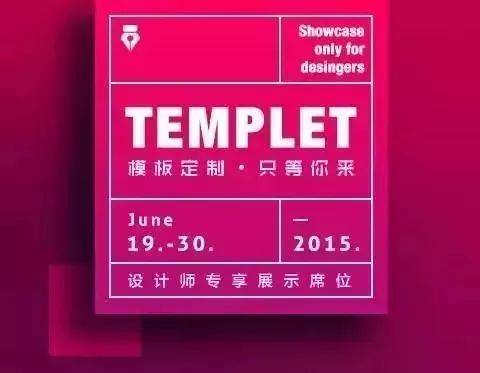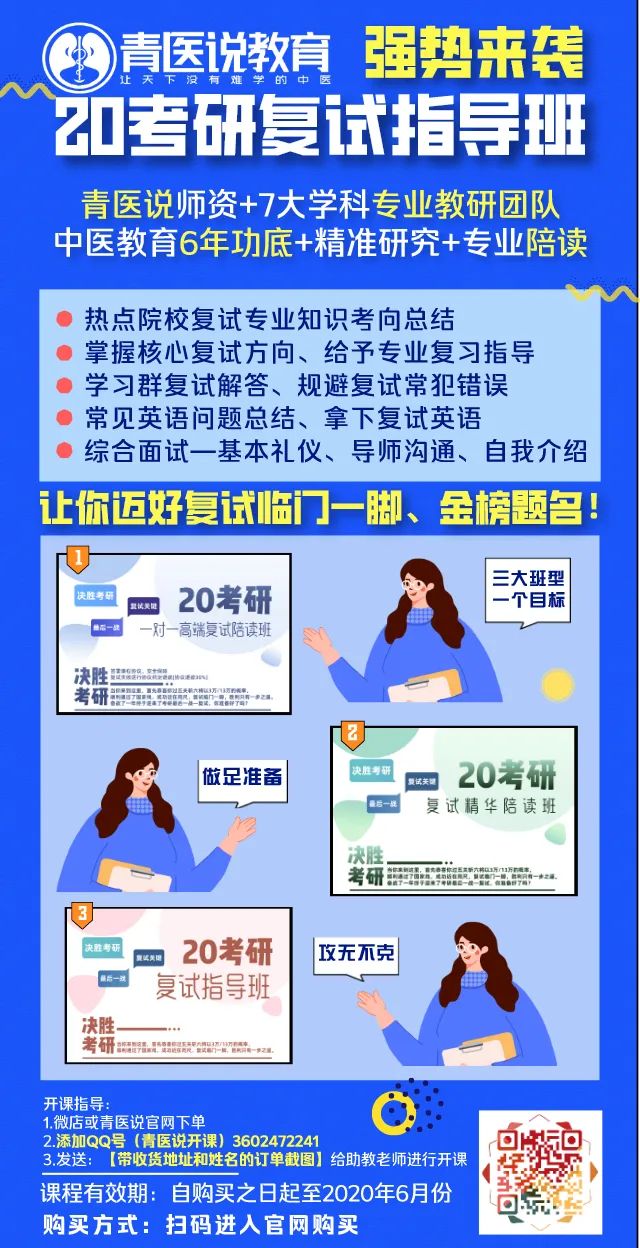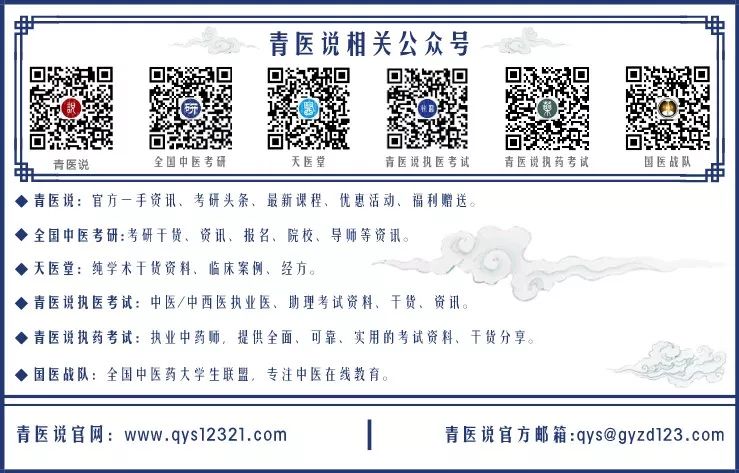

1. Má Huáng Tāng (Ephedra Decoction), Guì Zhī Tāng (Cinnamon Twig Decoction), Xiǎo Qīng Lóng Tāng (Minor Blue Dragon Decoction)
Differences:
Má Huáng Tāng combines Má Huáng (Ephedra) and Guì Zhī (Cinnamon Twig), providing a strong sweating effect and is effective in dispersing lung qi to relieve asthma. It is a pungent-warm formula suitable for exterior patterns of wind-cold with symptoms of chills, fever, and absence of sweating with cough.Guì Zhī Tāng combines Guì (Cinnamon) and Sháo (Peony), which is less effective in sweating and dispersing than Má Huáng Tāng, but it harmonizes the nutritive and defensive qi, making it a mild pungent-warm formula suitable for exterior patterns of wind-cold with sweating and aversion to wind.Xiǎo Qīng Lóng Tāng induces sweating to dispel wind-cold and disperse lung qi, warming and transforming water-dampness to alleviate cough and asthma, suitable for those with phlegm-dampness and wind-cold.2. Jiǔ Wèi Qiāng Huó Tāng (Nine Flavor Qiang Huo Decoction), Jiā Wèi Xiāng Sū Sǎn (Modified Xiang Su Powder)
Differences:Jiǔ Wèi Qiāng Huó Tāng is a pungent-warm formula that induces sweating and clears internal heat, suitable for exterior patterns of wind-cold with dampness, symptoms of chills, fever, absence of sweating, and body aches, along with bitter mouth and slight thirst.
Jiā Wèi Xiāng Sū Sǎn is a mild pungent-warm formula suitable for seasonal colds with mild chills and fever without sweating and slight thirst.
Bài Dú Sǎn (Dispersing Toxin Powder), Jiā Jiǎn Wēi Ruì Tāng (Modified Wei Rui Decoction)
Differences:Bài Dú Sǎn tonifies qi and releases the exterior, suitable for those with weak bodies who are affected by wind-cold-dampness, and can also be used for seasonal colds with exterior cold symptoms. Jiā Jiǎn Wēi Ruì Tāng nourishes yin and releases the exterior, suitable for those with yin deficiency who are affected by wind-heat.
Sāng Jú Yǐn (Mulberry Leaf and Chrysanthemum Decoction), Yín Qiáo Sǎn (Honeysuckle and Forsythia Powder)
Similarities:Sāng Jú Yǐn and Yín Qiáo Sǎn are both commonly used formulas for treating wind-heat exterior patterns.Differences:Sāng Jú Yǐn has a milder effect in releasing the exterior, focusing on dispersing lung qi, suitable for wind-heat attacking the lungs with cough and slight fever; Yín Qiáo Sǎn has a stronger effect in releasing the exterior and can clear heat and detoxify, suitable for initial stages of warm-heat with more heat than cold, symptoms of cough, sore throat, and thirst.5. Dà Huáng Fù Zǐ Tāng (Rhubarb and Aconite Decoction), Wēn Pí Tāng (Warming the Spleen Decoction)Similarities:Dà Huáng Fù Zǐ Tāng and Wēn Pí Tāng can both purge cold accumulation.Differences:Dà Huáng Fù Zǐ Tāng also warms the channels and disperses cold, primarily treating constipation due to cold accumulation in those with a weak constitution; Wēn Pí Tāng warms and tonifies spleen yang, primarily treating constipation due to insufficient spleen yang or chronic dysentery with red and white stools.6. Huáng Lóng Tāng (Yellow Dragon Decoction), Xīn Jiā Huáng Lóng Tāng (Newly Modified Yellow Dragon Decoction), Zēng Yè Chéng Qì Tāng (Increased Liquid Cheng Qi Decoction)Similarities:Huáng Lóng Tāng, Xīn Jiā Huáng Lóng Tāng, and Zēng Yè Chéng Qì Tāng can all purge heat and unblock the bowels while also supporting the righteous qi.Differences:Huáng Lóng Tāng uses Dà Chéng Qì (Major Order the Qi) to strongly purge heat accumulation, tonifying qi and nourishing blood, primarily treating severe heat accumulation with insufficient qi and blood; Xīn Jiā Huáng Lóng Tāng has functions of tonifying qi and nourishing blood while purging, primarily treating Yangming bowel heat with deficiency of righteous qi and severe damage to yin and blood; Zēng Yè Chéng Qì Tāng has functions of nourishing yin and increasing fluids while purging, primarily treating Yangming heat accumulation with dry stools and significant damage to yin fluids.7. Xiǎo Chái Hú Tāng (Minor Bupleurum Decoction), Bàn Xià Xiè Xīn Tāng (Pinellia Decoction to Drain the Heart), Hāo Qín Qīng Dǎn Tāng (Artemisia and Scutellaria Decoction)
Differences:Xiǎo Chái Hú Tāng is the primary formula for harmonizing Shaoyang, treating wind-cold invading Shaoyang, leading to alternating chills and fever, fullness in the chest and hypochondria, irritability, nausea, and lack of desire to eat.
Hāo Qín Qīng Dǎn Tāng clears the gallbladder and benefits dampness, harmonizing the stomach and transforming phlegm, primarily treating warm-dampness invading Shaoyang with phlegm-damp obstruction, with symptoms of more heat than cold, chest fullness, nausea, or vomiting of sour bile.
Bàn Xià Xiè Xīn Tāng harmonizes the stomach and descends rebellious qi, resolving fullness and distension, primarily treating mixed cold and heat in the stomach and intestines, with symptoms of fullness below the heart, vomiting, and diarrhea.
8. Sì Nì Sǎn (Frigid Extremities Powder), Tòng Xiè Yào Fāng (Essential Formula for Painful Diarrhea)Differences:Sì Nì Sǎn has the function of penetrating pathogens and relieving stagnation, regulating the spleen and uplifting yang, primarily treating internal stagnation of yang qi leading to cold extremities, cold hands and feet, or abdominal pain, diarrhea, and heavy stools.Tòng Xiè Yào Fāng primarily treats diarrhea due to liver invading the spleen, with symptoms of diarrhea and abdominal pain that persists after defecation.9. Shí Zǎo Tāng (Ten Jujube Decoction), Zhōu Chē Wán (Boat and Car Pill)Similarities:Shí Zǎo Tāng and Zhōu Chē Wán can both purge and eliminate water.Differences:Shí Zǎo Tāng has the additional function of tonifying the earth and supporting the righteous qi, primarily treating water retention and abdominal distension; Zhōu Chē Wán has a stronger action of moving qi and purging water, primarily used for water retention with significant abdominal distension.10. Xiān Fāng Huó Mìng Yǐn (Immortal Formula for Life), Pǔ Jì Xiāo Dú Yǐn (Universal Detoxifying Decoction)
Similarities:Xiān Fāng Huó Mìng Yǐn and Pǔ Jì Xiāo Dú Yǐn are both formulas for clearing heat and detoxifying.
Differences:
Pǔ Jì Xiāo Dú Yǐn treats major head plague, with swelling and toxins appearing on the head and face, using methods to clear heat and detoxify, disperse wind and eliminate pathogens, and assist in uplifting yang and dispersing stagnant heat; Xiān Fāng Huó Mìng Yǐn treats yang syndrome swelling and toxins, with methods to clear heat and detoxify, while also promoting qi and invigorating blood, dispersing masses and reducing swelling, especially effective for early-stage abscesses.
11. Xiān Fāng Huó Mìng Yǐn, Wǔ Wèi Xiāo Dú Yǐn (Five Flavor Detoxifying Decoction), Sì Miào Yǒng Ān Tāng (Four Marvels Tranquility Decoction)
Similarities:Xiān Fāng Huó Mìng Yǐn, Wǔ Wèi Xiāo Dú Yǐn, and Sì Miào Yǒng Ān Tāng are all commonly used formulas for yang syndrome sores and abscesses, all having the function of clearing heat and detoxifying.
Differences:Xiān Fāng Huó Mìng Yǐn is the key formula for early-stage abscesses, in addition to clearing heat and detoxifying, it also includes ingredients that disperse wind, invigorate blood, soften masses, and reduce swelling; Wǔ Wèi Xiāo Dú Yǐn focuses on clearing heat and detoxifying, with stronger detoxifying effects than Xiān Fāng Huó Mìng Yǐn, emphasizing dispersing toxins; Sì Miào Yǒng Ān Tāng primarily treats heat toxin excess, with a small amount of powerful herbs that must be taken continuously.
12. Zhú Yè Shí Gāo Tāng (Bamboo Leaf and Gypsum Decoction), Bái Hǔ Tāng (White Tiger Decoction)Differences:Zhú Yè Shí Gāo Tāng is derived from Bái Hǔ Tāng. Bái Hǔ Tāng is for excess heat with no deficiency, while Zhú Yè Shí Gāo Tāng is for diminished heat with residual heat affecting both fluids and qi. When heat is diminished and stomach qi is disharmonious, it removes the bitter and cold ingredients like Zhī Mǔ (Anemarrhena) and adds Rén Shēn (Ginseng) and Mài Dōng (Ophiopogon) to tonify qi and generate fluids, with Zhú Yè (Bamboo Leaf) to relieve irritability, and Bàn Xià (Pinellia) to harmonize the stomach. Bàn Xià is warm, but when combined with cooling and fluid-generating herbs, its warming and drying properties are mitigated, allowing it to assist in fluid transport, making it a good use of Bàn Xià.13. Qīng Yíng Tāng (Clear the Nutritive Decoction), Xī Jiǎo Dì Huáng Tāng (Rhinoceros Horn and Rehmannia Decoction)Differences:Qīng Yíng Tāng, compared to Xī Jiǎo Dì Huáng Tāng, includes herbs that clear heat and cool the blood, allowing heat entering the nutritive level to be resolved from the qi level, suitable for early-stage invasion of the nutritive level without affecting the blood; Xī Jiǎo Dì Huáng Tāng focuses on clearing heat and detoxifying, cooling the blood and dispersing stasis, used for heat affecting the blood level. The main symptoms differ, as does the depth of the pathogen.14. Bái Tóu Wēng Tāng (Pulsatilla Decoction), Sháo Yào Tāng (Peony Decoction)
Similarities:Bái Tóu Wēng Tāng and Sháo Yào Tāng are both formulas for treating dysentery.
Differences:Bái Tóu Wēng Tāng treats heat toxin dysentery, where heat toxins deeply invade the blood level, using methods to clear heat, detoxify, and cool the blood to stop dysentery; Sháo Yào Tāng treats diarrhea with red and white stools, belonging to damp-heat dysentery, while also addressing qi and blood imbalance, using methods to clear heat, dry dampness, and harmonize qi and blood, following the principle of “treating the cause to treat the effect,” allowing “when blood flows, pus resolves itself, and when qi is harmonized, the heaviness resolves itself.”
The main difference between the two formulas is that Bái Tóu Wēng Tāng clears heat, detoxifies, and cools the blood while Sháo Yào Tāng clears heat, dries dampness, and harmonizes qi and blood.
15. Zuǒ Jīn Wán (Left Metal Pill), Lóng Dǎn Xiè Gān Tāng (Gentiana Decoction to Drain the Liver)
Similarities:Both are used for liver channel excess fire, with symptoms of hypochondriac pain and bitter mouth.
Differences:Zuǒ Jīn Wán is primarily used for liver fire invading the stomach, with symptoms of vomiting and acid regurgitation, having the function of descending and harmonizing the stomach, but lacking the ability to clear damp-heat; Lóng Dǎn Xiè Gān Tāng is primarily used for liver fire attacking upward, with symptoms of red eyes, tinnitus, or damp-heat descending, with the ability to clear damp-heat but lacking the ability to harmonize the stomach.
16. Yù Nǚ Jiān (Jade Woman Decoction), Qīng Wèi Sǎn (Clear the Stomach Powder)
Similarities:Both treat stomach heat toothache.
Differences:Qīng Wèi Sǎn focuses on clearing stomach fire, using Huáng Lián (Coptis) as the chief herb, belonging to a bitter-cold formula, combined with Shēng Má (Cimicifuga) to disperse and detoxify, along with Shēng Dì (Rehmannia) and Dān Pí (Moutan) to cool the blood and disperse stasis, primarily treating toothache and gum swelling due to severe stomach fire; Yù Nǚ Jiān focuses on clearing stomach heat while also nourishing kidney yin, using Shí Gāo (Gypsum) as the chief herb, combined with Shú Dì (Rehmannia), Zhī Mǔ (Anemarrhena), and Mài Dōng (Ophiopogon) to nourish yin, primarily treating toothache and gum swelling due to strong stomach fire and insufficient kidney water.
17. Qīng Luò Yǐn (Clear the Network Decoction), Xīn Jiā Xiāng Rú Yǐn (Newly Modified Agastache Decoction), Liù Yī Sǎn (Six One Powder), Qīng Shǔ Yì Qì Tāng (Clear Summer Heat and Benefit Qi Decoction)① Qīng Luò Yǐn functions to clear summer heat, using light and clear herbs to treat summer heat injuring the lungs, suitable for mild cases. ② Xīn Jiā Xiāng Rú Yǐn functions to clear summer heat and release the exterior, clearing heat and transforming dampness, suitable for initial stages of summer warmth with concurrent exterior cold. ③ Liù Yī Sǎn has the function of clearing summer heat and benefiting dampness, primarily treating summer heat with dampness. ④ Qīng Shǔ Yì Qì Tāng is designed for summer heat injuring qi and fluids, combining heat-clearing with qi-boosting and fluid-generating herbs, addressing both the pathogen and the righteous qi.18. Lǐ Zhōng Wán (Regulate the Middle Pill), Wú Zhū Yú Tāng (Evodia Decoction)Similarities:Both treat middle jiao deficiency-cold syndrome.Differences:Lǐ Zhōng Wán warms the middle, dispels cold, and tonifies qi, often used as a decoction, primarily treating middle jiao deficiency-cold with abdominal pain and vomiting; Wú Zhū Yú Tāng warms the middle, tonifies deficiency, and descends rebellious qi, treating deficiency-cold in the Yangming, Jueyin, and Shaoyin channels, primarily focusing on vomiting due to cold.19. Sì Nì Tāng (Frigid Extremities Decoction), Huí Yáng Jiù Nì Tāng (Return the Yang and Rescue from Reversal Decoction)Similarities:Both treat weak yang qi and internal cold leading to cold extremities and critical conditions.Differences:Sì Nì Tāng is the primary formula for rescuing yang, treating internal cold with weak yang, leading to cold extremities, vomiting, diarrhea, and weak pulse, indicating a critical condition; Huí Yáng Jiù Nì Tāng not only rescues yang but also tonifies qi and nourishes the pulse, with the combination of Shè Xiāng (Musk) and Wǔ Wèi Zǐ (Schisandra) providing a complementary effect, suitable for internal cold with weak yang.20. Dà Chái Hú Tāng (Major Bupleurum Decoction), Fáng Fēng Tōng Shèng Sǎn (Siler and Ginseng Powder)Similarities:Dà Chái Hú Tāng and Fáng Fēng Tōng Shèng Sǎn are both formulas for releasing the exterior and attacking the interior.Differences:Dà Chái Hú Tāng harmonizes Shaoyang, purging heat accumulation, primarily treating Shaoyang and Yangming combined diseases, with alternating chills and fever, fullness or pain below the heart, constipation, or heat diarrhea as key diagnostic points; Fáng Fēng Tōng Shèng Sǎn combines exterior releasing with heat-clearing and purging, primarily treating wind-heat excess with both exterior and interior symptoms.21. Gè Gēn Huáng Qín Huáng Lián Tāng (Kudzu, Scutellaria, and Coptis Decoction), Shí Gāo Tāng (Gypsum Decoction)Similarities:Gè Gēn Huáng Qín Huáng Lián Tāng and Shí Gāo Tāng are both formulas for releasing the exterior and clearing the interior.Differences:The former clears heat and stops diarrhea, releasing the exterior while primarily treating diarrhea and dysentery with internal heat, while the exterior symptoms remain unresolved; the latter clears heat and detoxifies, inducing sweating and releasing the exterior, primarily treating exterior excess without sweating and severe heat in the three jiao.22. Sì Jūn Zǐ Tāng (Four Gentlemen Decoction), Lǐ Zhōng Wán (Regulate the Middle Pill)
Differences:Sì Jūn Zǐ Tāng and Lǐ Zhōng Wán both use Rén Shēn (Ginseng), Bái Zhú (Atractylodes), and Zhì Gān Cǎo (Honey-fried Licorice) to tonify middle qi, differing by only one herb, yet their functions are distinct. Sì Jūn Zǐ Tāng includes Fú Líng (Poria), primarily tonifying qi and strengthening the spleen, suitable for spleen and stomach qi deficiency; Lǐ Zhōng Wán uses Gān Jiāng (Dried Ginger), primarily warming the middle and dispelling cold, suitable for middle jiao deficiency-cold syndrome.
23. Yù Píng Fēng Sǎn (Jade Screen Powder), Guì Zhī Tāng (Cinnamon Twig Decoction)
Similarities:Yù Píng Fēng Sǎn and Guì Zhī Tāng can both be used to treat exterior deficiency with spontaneous sweating.
Differences:Yù Píng Fēng Sǎn’s spontaneous sweating is due to weak defensive qi and unstable pores; Guì Zhī Tāng’s spontaneous sweating is due to exterior wind-cold, with disharmony between nutritive and defensive qi. Therefore, Yù Píng Fēng Sǎn specializes in tonifying qi and stabilizing the exterior to stop sweating, while Guì Zhī Tāng focuses on releasing the exterior and harmonizing the nutritive and defensive qi.
24. Zhì Gān Cǎo Tāng (Honey-fried Licorice Decoction), Shēng Mài Sǎn (Generate Pulse Powder)Similarities:Zhì Gān Cǎo Tāng and Shēng Mài Sǎn both tonify lung qi and nourish lung yin, treating lung qi and yin deficiency with persistent cough.Differences:Zhì Gān Cǎo Tāng has a stronger effect on tonifying qi and nourishing yin, but its ability to restrain the lungs and stop cough is insufficient, focusing on treating the root cause, and is more suitable for warming tonification, while those with significant yin deficiency and internal heat are not suitable; Shēng Mài Sǎn, while not as strong in tonifying qi and nourishing yin, includes Wǔ Wèi Zǐ (Schisandra) for astringent effects, thus addressing both the root and symptoms, making it more effective in stopping cough, and is more suitable for cooling tonification, allowing for careful selection in clinical practice.25. Dà Bǔ Yīn Wán (Great Tonifying Yin Pill), Liù Wèi Dì Huáng Wán (Six Flavor Rehmannia Pill)Similarities:Dà Bǔ Yīn Wán and Liù Wèi Dì Huáng Wán can both nourish yin and reduce fire.Differences:Liù Wèi Dì Huáng Wán primarily nourishes kidney yin, but lacks sufficient heat-clearing ability; Dà Bǔ Yīn Wán has stronger functions in nourishing yin and reducing fire, thus is more suitable for those with significant yin deficiency and excess fire.26. Zuǒ Guī Wán (Left Return Pill), Liù Wèi Dì Huáng Wán (Six Flavor Rehmannia Pill)Similarities:Zuǒ Guī Wán and Liù Wèi Dì Huáng Wán are both tonifying kidney yin formulas.Differences:Liù Wèi Dì Huáng Wán primarily nourishes kidney yin, with a balanced tonifying effect, suitable for mild kidney deficiency with internal heat; Zuǒ Guī Wán is purely sweet and tonifying, with a stronger tonifying effect, suitable for significant deficiency of true yin and loss of essence. Thus, the medical text states: “Zuǒ Guī is for nurturing yin to encompass yang, not for strengthening water to control fire.”27. Zuǒ Guī Yǐn (Left Return Drink), Zuǒ Guī Wán (Left Return Pill)Similarities:Zuǒ Guī Yǐn and Zuǒ Guī Wán are both purely tonifying formulas, used for treating mild kidney yin deficiency.Differences:Zuǒ Guī Yǐn primarily uses sweet and tonifying ingredients to nourish yin and fill essence, with a milder effect, thus suitable for mild kidney yin deficiency; Zuǒ Guī Wán, while also nourishing yin, includes blood-nourishing and yang-supporting ingredients, with a stronger effect, commonly used for more severe kidney yin deficiency, focusing on a pill form for gradual treatment.
Qīng Yī Shūo (Qing Medicine Discussion)

Dedicated to Online Education in TCM
■ ■ ■ ■

 Editor: Qīng Níng
Editor: Qīng Níng




